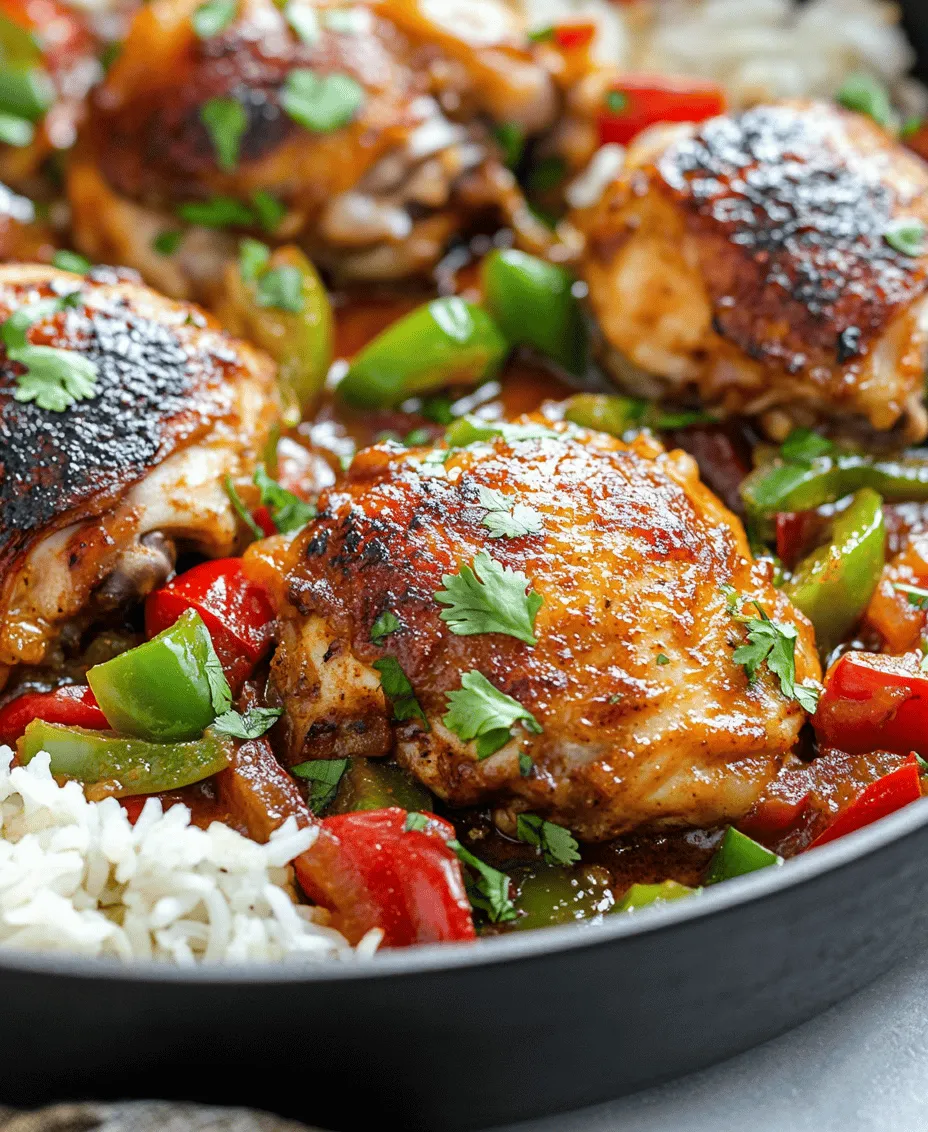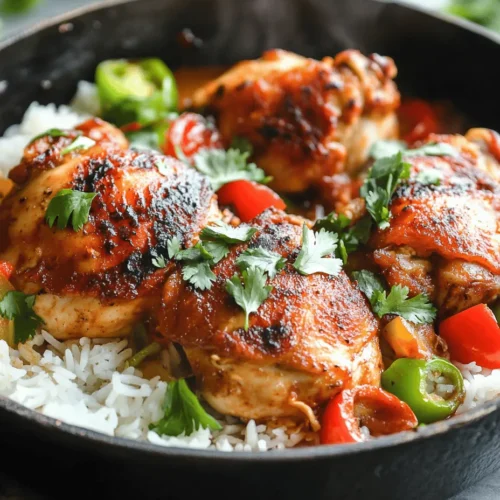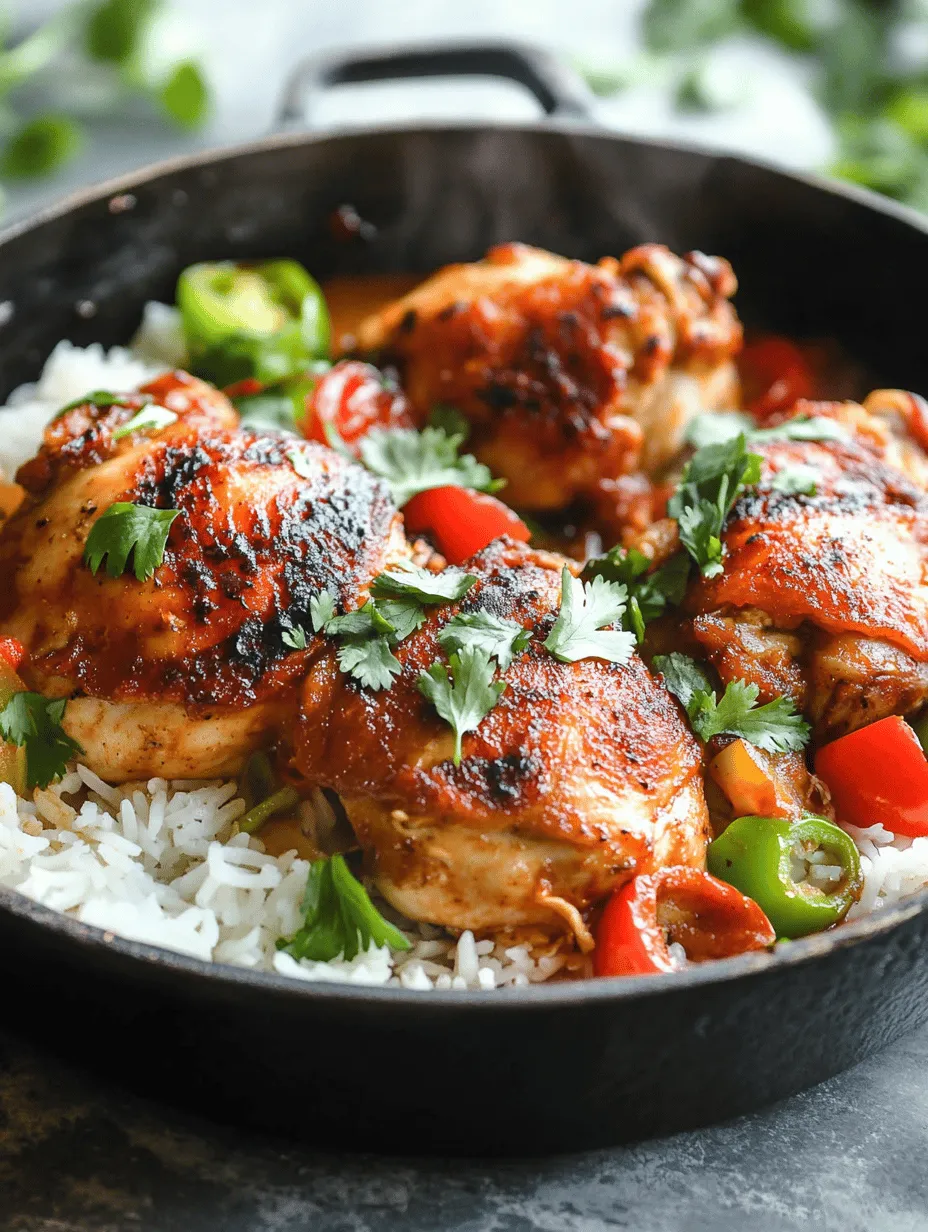Introduction
Brazilian cuisine is a vibrant tapestry woven from the country’s diverse cultural influences, showcasing a rich array of flavors that entice the palate. The culinary landscape of Brazil is renowned for its bold tastes, colorful ingredients, and the harmonious fusion of indigenous, Portuguese, African, and other international elements. Among the many delightful dishes that emerge from this South American culinary paradise, coconut chicken stands out as a beloved favorite.
Brazilian coconut chicken dishes, often characterized by their creamy textures and tropical flavors, are particularly popular in coastal regions where coconut palms flourish. The combination of succulent chicken and rich coconut milk creates a mouthwatering experience, while the addition of spices elevates the dish to new heights. This Spicy Brazilian Coconut Chicken recipe encapsulates those very qualities, offering a unique blend of heat and creaminess that is sure to excite adventurous eaters looking to explore new flavors.
In this article, we will dive into the preparation of Spicy Brazilian Coconut Chicken, highlighting the intricate balance of spices, the importance of fresh ingredients, and the techniques that transform simple components into a delectable feast. The dish’s unique combination of spicy red curry paste and creamy coconut milk results in a sumptuous sauce that envelops tender chicken thighs, making it a dish that is both comforting and exhilarating.
Understanding the Ingredients
To truly appreciate the flavors of Spicy Brazilian Coconut Chicken, it is essential to understand the key ingredients that contribute to its distinctive taste. Each component plays a crucial role in the final dish, and together they create a symphony of flavors that is emblematic of Brazilian cooking.
Chicken Thighs
One of the primary ingredients in this recipe is chicken thighs, which are favored for their rich flavor and tenderness. Unlike chicken breasts, dark meat from the thighs remains moist and juicy during cooking, making it an ideal choice for dishes that require longer cooking times. The higher fat content in chicken thighs lends itself well to absorbing the flavors of the spices and coconut milk, resulting in a more satisfying bite. Additionally, the skin can be left on to add even more flavor, as it crisps up beautifully during the cooking process.
Coconut Milk
Coconut milk is another star ingredient in this recipe, providing the creamy base that characterizes many Brazilian coconut dishes. Extracted from the flesh of mature coconuts, coconut milk is rich in healthy fats and offers a subtle sweetness that balances the spiciness of the red curry paste. Not only does it create a luscious sauce that clings to the chicken, but it also contributes to the overall depth of flavor in the dish. Plus, coconut milk is naturally dairy-free, making this recipe suitable for those with lactose intolerance or dietary restrictions.
Red Curry Paste
The introduction of red curry paste introduces a delightful kick to the dish. Originating from Southeast Asian cuisine, red curry paste is a blend of various spices, including red chili peppers, garlic, lemongrass, and galangal. Its complex flavor profile brings heat and aromatic qualities that complement the creaminess of the coconut milk. Depending on your spice tolerance, you can adjust the amount of red curry paste used in the recipe, allowing you to tailor the heat level to your preference.
Fresh Vegetables
To enhance the flavor and nutritional profile of the dish, fresh vegetables such as bell peppers and onions are included. Bell peppers add a sweet crunch, while onions provide a savory depth that rounds out the overall flavor. These vegetables not only contribute to the dish’s taste but also add essential vitamins and minerals, making the dish more wholesome. When sautéed, they develop a beautiful caramelization that enhances their natural sweetness, creating a delightful contrast to the spiciness of the chicken.
Balance of Flavors
The beauty of Spicy Brazilian Coconut Chicken lies in its exquisite balance of flavors. The spiciness from the red curry paste, the sweetness from the coconut milk, and the savory notes from the chicken and vegetables come together to create a harmonious dish that is both exciting and comforting. This balance is key to capturing the essence of Brazilian cuisine, which often emphasizes the interplay of diverse tastes and textures.
Marinating the Chicken
Marinating is an essential step in preparing Spicy Brazilian Coconut Chicken, as it allows the flavors to penetrate the chicken thighs, enhancing both their taste and tenderness. A well-executed marinade infuses the meat with spices and moisture, resulting in a more flavorful dish.
Importance of Marination
The marination process not only amplifies the flavor of the chicken but also helps to break down the muscle fibers, resulting in a more tender texture. For this recipe, a simple marinade can be created using a combination of red curry paste, coconut milk, and a touch of lime juice. The acidity from the lime juice acts as a tenderizer, while the coconut milk ensures that the chicken remains juicy during cooking.
Marinating Techniques and Timing
To properly marinate the chicken, begin by patting the thighs dry with paper towels. This helps the marinade adhere better to the meat. In a mixing bowl, combine the red curry paste, coconut milk, and lime juice to create the marinade. Coat the chicken thighs thoroughly in the mixture, ensuring that every piece is well-covered. For optimal flavor absorption, allow the chicken to marinate for at least 30 minutes; however, for best results, marinate for several hours or even overnight in the refrigerator. The longer the chicken marinates, the more pronounced the flavors will be.
Adjusting Spice Levels
If you are sensitive to spice, consider adjusting the amount of red curry paste used in the marinade. Start with a smaller amount, and taste the marinade before adding more to suit your personal preference. Keep in mind that the spiciness will mellow out once the chicken is cooked and combined with the coconut milk, so don’t be afraid to experiment with different spice levels.
Sautéing the Vegetables
Once the chicken has marinated, it’s time to prepare the accompanying vegetables. Sautéing is a cooking technique that enhances the natural flavors of ingredients through the application of heat, making it an ideal method for preparing the onions and bell peppers that will complement the chicken in this dish.
The Technique of Sautéing
Sautéing involves cooking food quickly in a small amount of oil over high heat. This technique allows the vegetables to caramelize, developing a rich flavor and appealing texture. When sautéing, it is important to keep the vegetables moving in the pan to ensure even cooking and prevent burning.
Achieving the Perfect Texture
For this recipe, start by heating a tablespoon of oil in a large skillet over medium-high heat. Once the oil is hot, add sliced onions and bell peppers to the pan. Sauté the vegetables for about 5-7 minutes, or until they become tender and slightly caramelized. The onions should turn translucent, while the bell peppers should maintain a slight crunch. This balance in texture is essential, as the sautéed vegetables will add a delightful contrast to the tender chicken.
Complementing the Chicken
The sautéed vegetables serve as a flavorful base for the chicken, enhancing the overall taste of the dish. Their natural sweetness and savory notes complement the spiciness of the chicken, creating a well-rounded flavor profile. Once the vegetables are cooked, they will be combined with the chicken and coconut sauce, allowing their flavors to meld together beautifully.
Cooking the Chicken
With the chicken marinated and the vegetables sautéed, it is time to cook the chicken thighs to perfection. This step is crucial in achieving a golden-brown finish while ensuring the meat remains juicy and flavorful.
Step-by-Step Cooking Process
1. Heat the Skillet: Begin by heating a bit more oil in the same skillet used for the vegetables, or use a clean skillet if preferred.
2. Brown the Chicken: Carefully add the marinated chicken thighs to the hot skillet, ensuring there is enough space between each piece to allow for even cooking. Cook the chicken for about 6-8 minutes on one side until it develops a beautiful golden-brown crust.
3. Flip and Cook Through: Once browned, flip the chicken thighs over and continue cooking for an additional 6-8 minutes on the other side. It’s important to monitor the internal temperature of the chicken using a meat thermometer; it should reach 165°F (74°C) to ensure food safety.
Preventing Overcooking
To prevent the chicken from becoming overcooked and dry, avoid cooking it at too high of a temperature. Medium to medium-high heat is ideal for achieving a nice sear without burning the exterior. Additionally, refrain from moving the chicken around too much during cooking; allowing it to sear undisturbed will enhance the crust and flavor.
Ensuring Juiciness
Once the chicken is cooked through, remove it from the skillet and let it rest for a few minutes before slicing. This resting period allows the juices to redistribute throughout the meat, ensuring each bite is tender and juicy.
Creating the Coconut Sauce
Following the cooking of the chicken, we will create the luscious coconut sauce that ties the entire dish together. The combination of the sautéed vegetables, marinated chicken, and coconut milk will form a creamy, flavorful sauce that envelops the dish in a tropical embrace.
Building the Sauce
1. Combine Ingredients: In the same skillet used for the chicken and vegetables, add the remaining coconut milk and any marinade left in the bowl. Stir to incorporate the flavors left behind from the chicken and vegetables.
2. Simmer: Bring the mixture to a gentle simmer, allowing it to thicken slightly. This will create a rich sauce that clings beautifully to the chicken. Taste the sauce and adjust the seasoning as needed, adding salt, pepper, or additional red curry paste for more spice.
3. Combine Everything: Once the sauce is at the desired consistency, return the cooked chicken and sautéed vegetables to the skillet, ensuring they are well-coated with the sauce. Allow everything to simmer together for a few minutes to meld the flavors.
As we continue with the recipe, you will see how these elements come together to create a truly unforgettable dish that showcases the vibrant flavors of Brazilian cuisine. Stay tuned for the next steps, where we will finalize our Spicy Brazilian Coconut Chicken and explore how to serve it for maximum enjoyment.

Combining the Ingredients for a Luscious Sauce
To create a luscious sauce for your Spicy Brazilian Coconut Chicken, begin by incorporating the sautéed onions, garlic, and ginger into your pan, allowing them to mingle with the spices you’ve selected. Next, add the diced tomatoes, which will provide acidity and depth to the sauce. Stir well to ensure that the tomatoes break down and release their juices, creating a beautiful base for your coconut milk.
Now, it’s time to pour in the star ingredient—coconut milk. Use full-fat coconut milk for a creamier texture that envelops the chicken and vegetables. Bring the mixture to a gentle simmer, and watch as the flavors meld together beautifully. If you find the sauce too thick, you can add a splash of chicken broth or water to achieve your desired consistency. Conversely, if the sauce seems too thin, let it simmer uncovered for a few additional minutes, allowing it to reduce and thicken.
As the sauce simmers, take the opportunity to taste and adjust the seasoning. This step is crucial; everyone’s palate is different, and you may want to add additional salt, pepper, or even a pinch of sugar to balance the acidity of the tomatoes. Consider adding a splash of lime juice for brightness or a dash of hot sauce for an extra kick. Remember, this dish is about personalizing the flavors to suit your taste.
Serving Suggestions
Once your Spicy Brazilian Coconut Chicken is ready, it’s time to serve it in style. This dish pairs exceptionally well with fluffy white rice. The rice acts as a perfect canvas, absorbing the rich, creamy sauce while providing a neutral balance to the spiciness of the chicken. You can opt for jasmine or basmati rice for an aromatic twist or stick with traditional short-grain rice for authenticity.
For additional sides, consider serving a fresh salad made of mixed greens, tomatoes, and avocado. This salad will provide a refreshing contrast to the richness of the chicken. Alternatively, grilled vegetables such as zucchini, bell peppers, and corn on the cob can add vibrant colors and flavors to your plate.
Garnishing your dish with fresh cilantro is not just for aesthetics; it adds a burst of freshness that enhances the overall taste. If you enjoy a bit of crunch, sprinkle some toasted coconut flakes on top for a delightful texture.
When it comes to beverages, a chilled caipirinha—a classic Brazilian cocktail made with cachaça, lime, and sugar—pairs wonderfully with this dish. If you prefer non-alcoholic options, opt for a refreshing coconut water or a tropical fruit juice, such as passionfruit or mango, to complement the creamy and spicy notes of the chicken.
Cultural Significance
Coconut chicken is not just a dish; it represents the heart and soul of Brazilian cuisine. Originating from the diverse culinary traditions of Brazil, it showcases a beautiful blend of indigenous ingredients and colonial influences. The use of coconut milk is a testament to the tropical abundance of Brazil, particularly in the northeastern regions where coconuts thrive.
Historically, the fusion of native culinary practices with those of Portuguese colonizers led to unique dishes that reflect Brazil’s multicultural heritage. Coconut milk, a staple in many Brazilian recipes, reflects the indigenous use of local produce, while spices such as chili and garlic highlight the influence of African and European cooking traditions.
The popularity of coconut milk extends beyond just this dish; it is a key ingredient in many Brazilian curries, soups, and desserts, making it a versatile component in the nation’s culinary repertoire. Each region of Brazil has its own variations of coconut chicken, demonstrating the diversity of flavors and techniques that exist within the country’s rich gastronomic landscape.
Health Benefits of Ingredients
The Spicy Brazilian Coconut Chicken is not only delicious but also packed with nutritional benefits. The primary ingredient, coconut milk, is rich in healthy fats known as medium-chain triglycerides (MCTs), which are known to provide quick energy and support metabolism. These fats can help improve heart health and may even aid in weight management when consumed in moderation.
Chicken is a fantastic source of lean protein, essential for building and repairing tissues, and it plays a crucial role in maintaining muscle mass. Additionally, it is low in calories and high in essential vitamins and minerals, including B vitamins that support energy production.
The addition of vegetables such as bell peppers, tomatoes, and onions not only enhances the flavor profile of the dish but also adds fiber, vitamins, and antioxidants. Spices like turmeric and chili pepper provide anti-inflammatory benefits and can boost metabolism as well.
Incorporating this dish into your weekly meal plan is a delicious way to enjoy a balanced diet while experiencing the vibrant flavors of Brazil.
Variations and Adaptations
One of the great features of Spicy Brazilian Coconut Chicken is its adaptability. For those following a vegan diet, you can replace the chicken with firm tofu or chickpeas for a protein-packed alternative. Simply sauté the tofu until golden, then follow the same cooking steps for the sauce.
Additionally, feel free to experiment with seasonal vegetables. Adding in leafy greens like kale or spinach can enhance the nutritional value of the dish and add a lovely color contrast. You could also introduce different spices or herbs based on your preference; for instance, replacing chili powder with smoked paprika can create a unique flavor profile.
Regional variations abound in Brazil. For example, in some areas, the dish may include shrimp or fish, highlighting the coastal influences of Brazilian cuisine. You can also incorporate regional spices—like cumin or coriander—to reflect your personal taste or encourage a fusion with other culinary styles.
Conclusion
Spicy Brazilian Coconut Chicken is more than just a meal; it is a celebration of flavors that encapsulates the essence of Brazilian cuisine. The combination of tender chicken simmered in a creamy, spicy coconut sauce is not only mouthwatering but also a dish that brings people together.
By embracing the simplicity of this recipe, you have the opportunity to share a taste of Brazil with family and friends. Whether you are enjoying it on a weeknight or serving it during a special gathering, this dish promises to impress.
So, roll up your sleeves, gather your ingredients, and embark on this culinary journey. The joy of cooking and sharing this vibrant dish is sure to be a delightful experience. Embrace the flavors of Brazil, and let the Spicy Brazilian Coconut Chicken become a cherished addition to your recipe collection.



